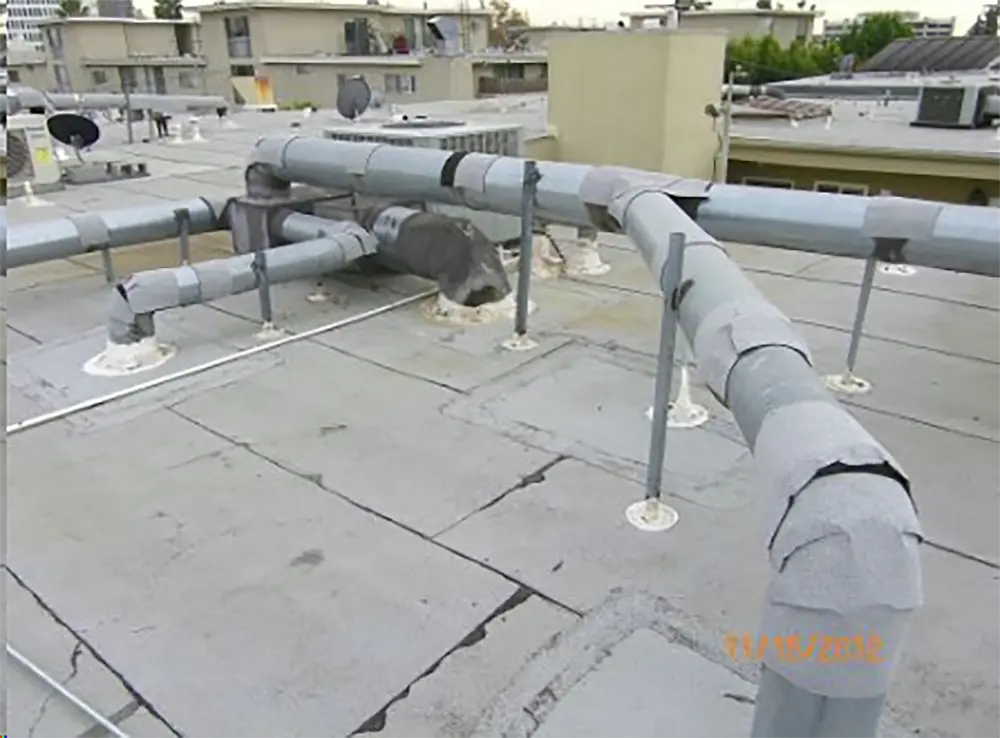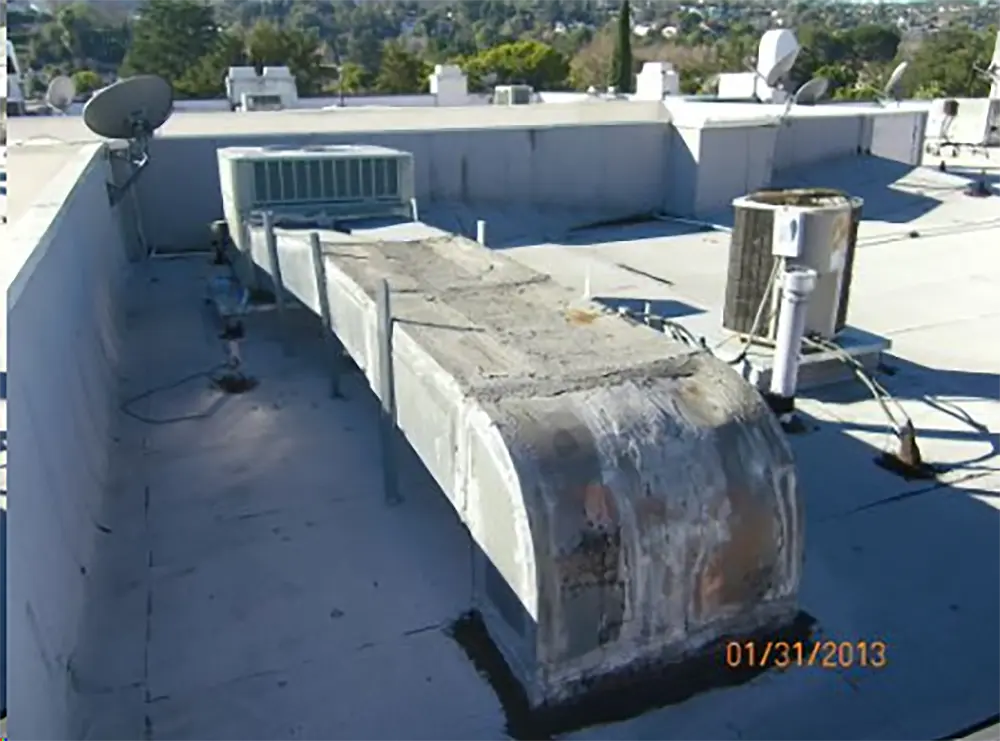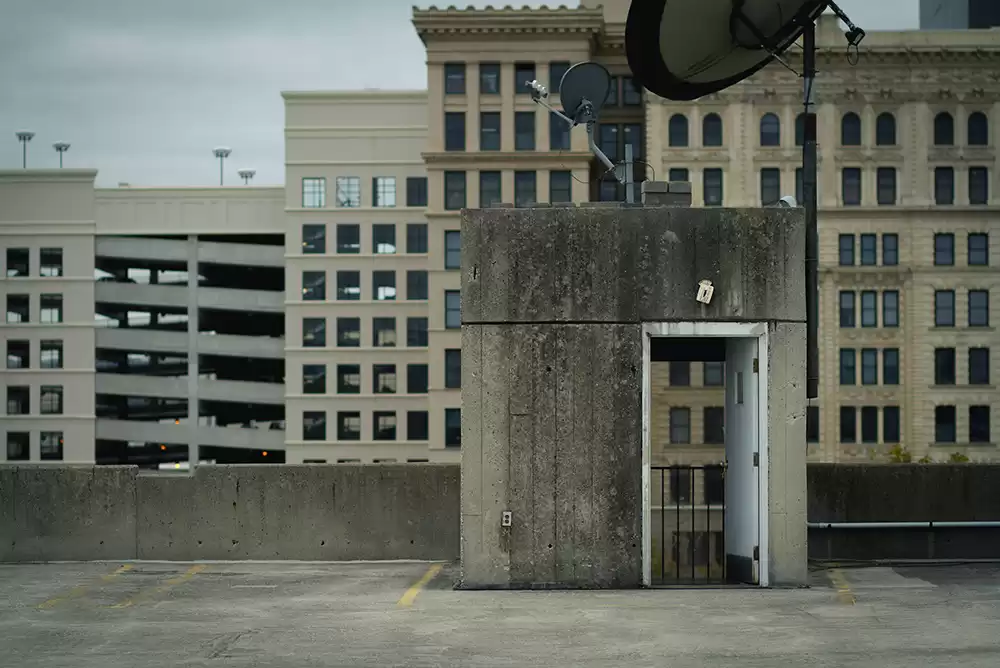By Dan Cahill and Gary Stewart
Commercial roof leaks can be a massive problem for Southern California businesses, apartment complexes, and HOAs. Not only is there the cost of the repair to consider, but also the disruption to operations and the risk of more severe damage to the structure of the roof or the building itself.
But what if I told you that many, if not most, roofing leaks can be attributed to a single cause, and that cause is almost entirely preventable? Well, it’s true! In our experience, the single leading cause of commercial roof leaks is (drum roll) roof-mounted air conditioning units.
How AC Units Cause Roof Leaks
There are several reasons why air conditioning units (AC units) are a significant factor in commercial roof leaks, especially in Southern California. Here’s an in-depth look into these reasons and how to prevent or correct these issues.
Location and Installation
Improper installation can range from poor initial roofing integration to inadequate leveling, which affects drainage. Issues can also arise when new systems are tied into old ducting or platforms. Cost-cutting measures, such as using existing ducting or platforms without proper modifications, often result in poorly matched connections that become leakage points.

In Southern California, AC units are typically located on the roof due to the high value of real estate. Unlike other parts of the country where AC units may be placed on the ground, the rooftop installation conserves valuable ground space. However, this placement introduces unique challenges.
The initial installation of an AC unit on the roof requires proper roofing integration. If the unit is not correctly roofed in, it can lead to problems within a short period, possibly by the first rain or within a couple of years. Ensuring the unit is correctly integrated into the roofing system is crucial to prevent early leaks.
Maintenance
Many AC units are neglected. In a recent project at a shopping center, every unit had leaks or blockages due to a lack of maintenance. Roofing around AC units is prone to wear and tear that occurs faster than the rest of the roof. Regular maintenance is crucial to prevent leaks and backups.
While a properly maintained roof might be expected to last 20 years, the areas around AC units often require servicing every few years to address touch-ups or resealing. Neglecting this maintenance can lead to leaks from the AC unit’s platform or roof penetrations.
Replacement Issues
When replacing old AC units with new ones, proper care must be taken to protect the roof. The process involves removing the old unit and placing the new one, which can easily damage the roof if not done carefully. AC units are heavy and have sharp metal corners that can puncture or tear the roofing material if adequate protection measures are not in place. Often, HVAC technicians may not be trained to protect the roof during these operations, focusing solely on their trade.
Condensation Problems
Most AC units in California are primarily used for cooling, especially during the hot summers. The cooling process generates condensation, which needs to be correctly drained to prevent roof damage. Condensation is usually channeled through a pipe into a drain line. However, these pipes, often made of PVC, can crack or dislodge due to sun exposure or physical disturbance, causing water to back up and spill onto the roof.
This continuous exposure to moisture can damage the roof, as it is not designed for prolonged water contact. Moreover, condensate water is chemically hard and abrasive, accelerating the deterioration of the roofing material.
Types of AC Units Likely to Cause a Leak
Older AC units are more likely to cause issues that result in commercial roof leaks. The type of AC unit used in high-rise buildings, which are less common in Southern California but do exist, can also influence the risk of leaks.
Older AC Units
Older AC units are more likely to leak due to wear and tear over time. Components can degrade, leading to improper sealing, cracked pipes, and other issues that allow water to penetrate the roof.

High-Rise Buildings and Chilling Units
High-rise buildings often use different types of air conditioning systems, particularly chilling units. These units are like advanced swamp coolers, relying on circulating large amounts of water to chill the air before pumping it back into the building.
Potential Issues with Chilling Units include:
- Water Circulation: Chilling units circulate hundreds of gallons of water, unlike typical AC units that primarily produce condensation. Water circulation increases the potential for leaks and water damage.
- Splashing and Wind: On windy days, water can splash from these units onto the roof, leading to potential leaks and damage.
- Panel Issues: Missing or improperly secured panels can exacerbate these issues by allowing more water to escape.
- Inadequate Maintenance: Proper maintenance is crucial. A lack of regular service can lead to significant water-related problems.
The Risks of Uncorrected Roof Leaks
Over time, AC-induced roof leaks can significantly impact a building’s structural integrity. Promptly addressing these leaks is crucial to avoid extensive damage.
Immediate Response
If you notice a leak during the summer when it’s hot and not raining, it’s likely related to the AC unit. Promptly addressing this leak can prevent long-term damage, and immediate attention ensures the leak doesn’t compromise the building’s structure.
Long-Term Effects
If a leak goes unnoticed or ignored for months or even years, it can lead to severe structural damage. Most buildings in Southern California are wood-frame constructions. Wood is porous and absorbs water like a sponge. Continuous exposure to water weakens the wood, reducing its strength and rigidity. While a single leak might not cause significant damage, prolonged exposure will.
Incremental Damage
Repeated or prolonged leaks result in incremental damage. Over time, the absorbed water weakens the wood, leading to structural concerns. Promptly Addressing leaks can prevent this incremental damage and maintain the building’s structural integrity.
Cost of Neglect
Ignoring a leak can lead to costly repairs. What might initially be a $500 or $1,000 repair can escalate into thousands of dollars in structural repairs if neglected. The old adage, “an ounce of prevention is worth a pound of cure,” holds true. Preventative measures and timely repairs are essential to avoid expensive and extensive damage in the long run.
A Real World Example
A few weeks ago, we were re-roofing a gymnasium. Given the nature of a gym, it’s critical to maintain a cool, comfortable environment. Nobody wants to work out in a hot, humid gym. Before starting the re-roof, we conducted a job walk to ensure the AC units were running correctly and that the condensate lines were connected. The walk-through occurred on a relatively cool day, so everything seemed fine.
Fast forward to the actual roof project, and the weather turned scorching. During the re-roof, the gym experienced significant leaks. Despite our earlier checks showing the condensate lines were properly sloped and unclogged, the problem lay within the AC units themselves. Inside the units where the condensate is generated, there was an issue that caused water to leak directly into the space below, bypassing the condensate lines entirely.
Persistent water leakage can lead to severe problems. Mold growth, for instance, requires prolonged moisture to develop. In this case, the gym had to shut down four of its eight AC units to prevent further damage and potential mold growth, which is hazardous in any environment but especially problematic in a gym where people are actively exercising.
Additionally, this shutdown turned the climate-controlled facility into one struggling to maintain a suitable temperature for its clients, directly impacting the gym’s operations and client satisfaction. A more rigorous maintenance schedule could have avoided much of this challenge.
Maintenance Strategies and Best Practices
Preventing AC-related roof leaks starts with regular inspections. It is crucial to have someone service your roof and AC unit on a yearly or regular basis. Regular inspections help identify problems early, allowing for timely fixes before they become major issues.
Regular Inspections
Visual Inspections: The first step is regular visual inspections. Visual inspections involve checking any roof penetrations related to the AC unit. These areas need periodic resealing. While annual inspection is recommended, resealing may only be necessary every three to five years, depending on the products used and wear and tear. Early detection of potential issues is key.
Maintenance of Penetrations
Penetration Sealing: Roof penetrations for AC units should be checked and resealed at appropriate intervals. Just like car maintenance, where you monitor brake wear and replace them before they fail, roof penetrations should be monitored and maintained before they develop significant issues. Yearly inspections of these areas help catch the early signs of wear.
AC Platforms
AC Platform Maintenance: AC platforms are typically roofed in and have areas where the roof transitions at a 90-degree angle. These points are stress points and are prone to cracking as they age. Reinforcing these areas during installation and periodically redoing the reinforcement helps maintain the roof’s integrity. The reinforcement has a shelf life and needs to be renewed as required.
Condensate Line Maintenance
Condensate Lines: Properly maintaining condensate lines is crucial. These lines should be connected correctly, have the proper slope, and be free of clogs to ensure that water drains properly without spilling onto the roof. Regularly checking and adjusting these lines prevents water from accumulating on the roof, protecting it from continuous moisture exposure.
Additional Advice
Here’s some advice for property owners and HOA managers to better handle these issues:
Regular Inspection Cycle
Establish a regular inspection cycle, ideally at least once a year. Regularly inspect the roof, including AC-related components, to catch and prevent potential issues. Prevention is the best course of action.
AC Unit Maintenance
Schedule yearly or bi-yearly maintenance for AC units. While the technician is up there changing filters or performing other tasks, they should also inspect the unit thoroughly. Through inspections include checking seals, ensuring all screws are in place, and examining rubber grommets. These grommets, which seal the screws, can wear out due to sun, rain, and seasonal changes, becoming potential leak points.
Comprehensive Inspections
Ensure that maintenance involves more than just changing a filter. A technician charging a minimal fee for filter changes is unlikely to perform a thorough inspection. Investing in comprehensive maintenance can prevent small issues from becoming major problems.
When replacing AC units, ask the contractor about their standard practices for protecting the roof. Ensure they take steps to avoid causing damage. Follow up with your trusted roofing contractor to inspect the roof after the AC unit replacement. This proactive step helps catch any issues early, ideally in favorable weather conditions, rather than waiting for a rainy season when demand for repairs is high.
Aim to inspect and address any potential roof issues during the summer or dry periods. This controlled demand period allows for repairs to be made without the pressure and higher costs associated with winter and stormy weather. Identifying and fixing problems in dry conditions ensures that repairs are done efficiently and timely, avoiding the rush and potential delays of peak repair seasons.
Conclusion
By implementing regular inspections, thorough maintenance, and proactive coordination during AC unit replacements, property owners and HOA managers can effectively manage and mitigate the risks associated with AC-related roof leaks. The goal is to prevent problems and address any issues promptly, ensuring the longevity and integrity of the roof and the comfort and safety of building occupants.
Are you in need of repair? Be proactive today and have a professional inspect your roof leak!
Author Bio
As a proud fourth-generation commercial roofing contractor, Gary Stewart has dedicated his career to upholding the legacy of quality and craftsmanship established by his family. Today, as a managing partner, he works alongside his relatives, blending tradition with innovation to deliver exceptional roofing solutions. His commitment to excellence and teamwork not only strengthens SBR Roofing’s projects but also deepens those family bonds, ensuring that every roof we build is a testament to our shared values of integrity, durability, and service. Together, we are not just constructing roofs; we are building a future for our community and our family lineage.
Dan Cahill embarked on his journey in 2001, accumulating over 23 years of experience in the commercial roofing field. The original owner of SBR Roofing extended a trial opportunity in 2001, coinciding with the burst of the dot-com bubble. The proposition was simple: give it a year, see if it suits you, and if not, no hard feelings. Surprisingly, Dan found himself sticking around. Fast-forward over two decades, and he continues to thrive in the field.
With a background in sales, Dan discovered a passion for the dynamics of salesmanship, particularly in the freedom it offered from the confines of a desk. The opportunity to engage with people, navigate various situations, and even climb up on roofs appealed to him. This intriguing experience kept Dan hooked, prompting him to stay the course, eventually becoming a leader in the roofing industry.







